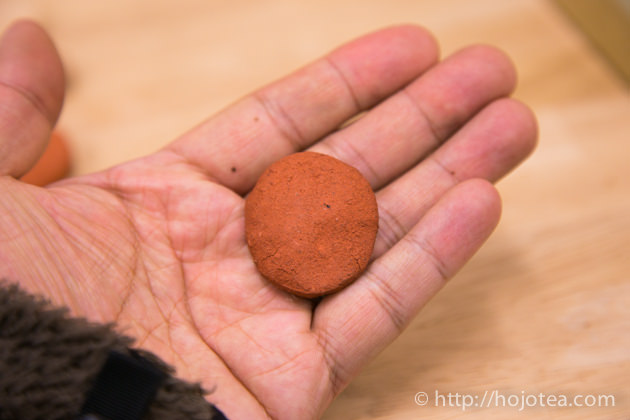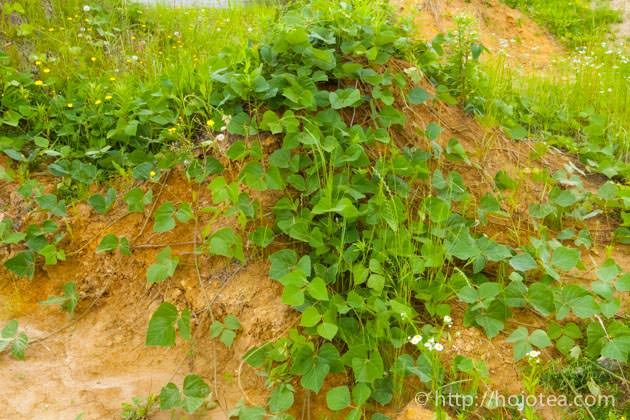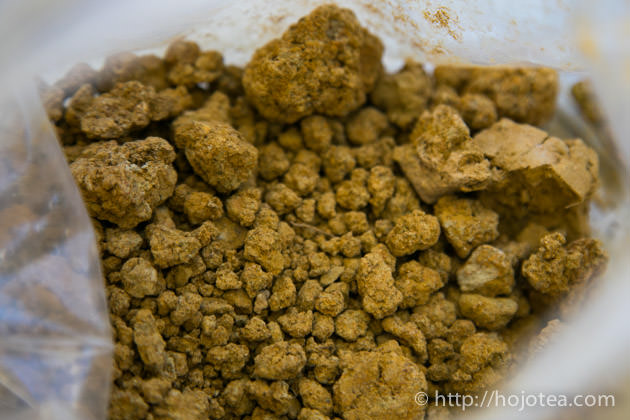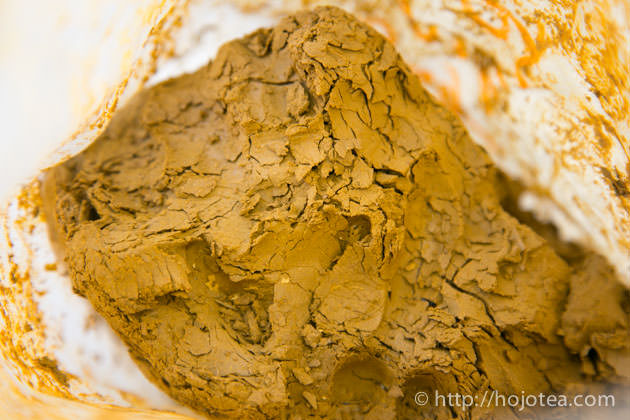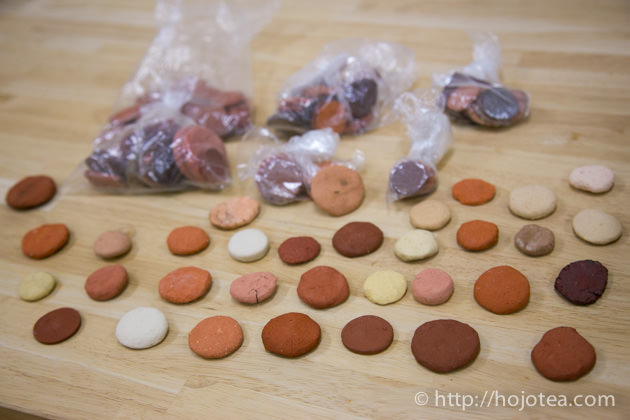Collection: Iga Natural Red Clay 伊贺天然朱泥
This is our specialty clay that I personally discovered. This high-quality, natural red clay hails from Iga, known as the Ninja Village in Mie Prefecture.This clay is suitable to use for all types of tea.
Nevertheless, it's important to note that this clay is made entirely from natural materials, making it highly porous. As a result, when first used, tea may seep into the surface of the clay. For more details, please see the description below.
A Soil That Enhances the Aroma of Black and Oolong Teas
Even within the red clays produced in Iga, the soil's characteristics vary depending on where it's sourced. The clay we have selected enhances the richness (body) and aftertaste (flavor) of tea. By "richness," we refer to the breadth of the tea's aroma. As you drink the tea, the aroma and flavor gently spread, creating a very rich sensory experience. This type of clay is ideal for fermented teas like black tea, oolong tea, and Pu-erh tea. When used for brewing Japanese teas, it significantly enhances the aroma and leaves a lasting sweetness on the sides of the palate.
The richness of tea is closely tied to the presence of stems, but modern Japanese teas often prioritize appearance, leading to the removal of stems and, consequently, a reduction in depth. However, when brewed with Iga clay, Japanese teas are transformed, gaining a rich, full-bodied flavor.
Discovering the Ideal Natural Red Clay in Iga, the Ninja Village
We focused on Iga clay due to the rich, full-bodied flavors found in both Iga's sake and its Asagami tea. We believed that Iga's soil would have similar properties. While Iga and Shigaraki are primarily known for their white clay, these regions also produce exceptional natural red clay.
In collaboration with natural soil experts, we screened nearly 100 different types of native soils. The red clay we discovered, collected from the uppermost layer of soil near a mountaintop in Iga, exhibited fascinating characteristics. This thin layer, only about 10-20 cm thick, lay just beneath the leaf mold on the mountain surface. The clay itself had the distinctive yellow hue of raw red clay, but the sample we collected had an especially deep yellow color, giving it a unique presence. However, it contained coarse sand, which we removed through careful refinement. After processing and testing the clay, we were amazed by its strong body and the way it enhanced the aroma of tea. When used with oolong or black tea, the clay brought out a delightful fragrance, far exceeding our expectations. Through additional tests with different refining methods, we optimized the process to achieve the best results.
(Note: Red clay refers to soil that appears yellow in its raw state but turns red after firing due to oxidation. In China, this raw yellow soil is known as "紅泥.")
Test Pieces of Unrefined Iga Soil (As Obtained)
What we were able to obtain was roughly enough soil to fill a small truck.
As previously mentioned, the soil we found this time is exceptionally rare, and even if we were to buy it all, it would only fill up a small truck. In its natural state, straight from the mountain, it contains various impurities such as dried grass and sand, so further filtration and refining of the soil are necessary to process it into clay. For this purpose, we have entrusted the task to specialized refining professionals who will carry out a series of refining processes to transform it into a clay-like consistency.
Unrefined Iga Natural Red Clay
Refined Iga Natural Red Clay
Firing Experiment Using Completely Homogeneous Red Clay: Increasing Temperature from left to right
Performance varies significantly even with red clay from the same region
Not all natural red clays are created equal. When it comes to natural soil, it's important to note that it is, quite literally, naturally sourced, which means it can contain various impurities, including sand. In fact, we consider it a success if we find one reasonably good soil among 10 different red clays that we test. Even in the same region, the properties of the soil can dramatically differ based on the layer and location. Some soils can enhance the depth of flavor and aroma, intensify the aftertaste, broaden the taste, and increase the sweetness felt on the sides of the mouth when drinking tea, thereby enhancing the overall satisfaction of the tea-drinking experience. Conversely, certain soils can impart bitterness to the tea, diminish the inherent richness and body of the tea, and flatten the taste and aroma. Soil, depending on its type, can either improve or worsen the taste of the tea. To find natural red clay suitable for teapots, HOJO employs various screening methods.
Various test pieces are screened in the search for soil with the desired characteristics
Yixing teapots: Witnessing changes in quality from the past to the present
In China, the relationship between the clay used in teapots and the taste of tea has been a subject of significant attention for centuries. Particularly, Yixing red clay, produced in Jiangsu Province, has gained recognition not only within China but also among tea enthusiasts worldwide due to its exceptional performance. The presence of excellent clay in Yixing wasn't a result of Yixing potters possessing extraordinary discernment. While Yixing teapot makers are experts in ceramic artistry, they are not necessarily experts in taste. The discovery and use of fine clay for teapot making in Yixing came about because there were connoisseurs and cultural figures in Yixing who understood the value of teapots. They had a clear understanding of the relationship between the material and the taste of tea, and they continuously sought superior clay from which to craft teapots. It was their efforts that led to the selection of exceptional clay and elevated Yixing to global fame.
Yixing possesses geological advantages as a region where red clay is abundant, and it also belongs to a culturally rich area within Jiangsu Province. In fact, when traveling through other provinces in China, you can find high-quality red clay similar to Yixing's almost everywhere. However, no matter how good the clay is, without both skilled ceramic artists capable of processing the clay into teapots and buyers who can appreciate the taste, it cannot become a second Yixing. Despite these favorable conditions, in recent years, Yixing's reputation has grown to such an extent that it has overshadowed its actual qualities. As a result, it has become exceedingly difficult to obtain teapots made from clay with the same performance as the old Yixing clay. In today's market, many products are made from blended clay, making teapots crafted from clay with the performance equivalent to the old Yixing red clay extremely rare.
In Yixing
At a Soil Dealer in Yixing
Historically, Japanese tea utensils have been crafted with a focus on aesthetics. In Japan, ceramics have emphasized the relationship between material, texture, and color, often represented by the concept of "Wabi-Sabi," which values the connection between materials and their qualities and hues. Of course, many Japanese people believe that teapots and earthenware pots enhance the taste of tea and food, creating a "mellow" flavor. However, the precise understanding of how different materials affect the degree of mellowness, let alone the relationship between body, richness, and the material of the clay, is not accurately understood even in well-known teapot-producing regions in Japan. Additionally, an excessive emphasis on color can sometimes lead to clay that not only fails to mellow the taste but also diminishes richness, body, and flavor or increases astringency.
Performance of Clay Unrelated to Price or the Fame of the Potter
When seeking high-performance tea utensils, the price or rarity of the teapot should not be the sole criteria for selection. Extremely expensive teapots, artistically crafted teapots, or those created by renowned potters will not inherently outperform other teapots in terms of taste unless the relationship between the clay and taste has been verified. Teapot makers are experts in ceramic artistry but not necessarily experts in taste. To create a teapot with superior performance, collaboration between ceramic experts and taste or tea experts is required.
At HOJO, we consider the search for good clay to be crucial for producing teapots with excellent performance (enhancing the taste of tea). While it may be called "clay hunting," we are not searching for new teapot makers; we are literally searching for clay. The key criterion in this search is the impact on the taste of tea, but at the same time, the clay must have the strength to support the functionality of the teapot when fired. To find superior clay from natural sources, HOJO continually evaluates various clays in pursuit of those that excel in terms of tea taste and aroma.
Evaluating the Relationship Between Clay and Taste
In my case, to evaluate the relationship between clay and taste, I knead the raw clay and create cookie-like test pieces, which I then fire in the electric kiln owned by our company. After firing, I immerse the resulting "cookies" in tea to assess changes in taste and aroma. During evaluation, I assess various aspects such as body, richness, and astringency individually. As I narrow down the clay selection, I conduct more detailed tests, examining factors like clay fineness and its relationship with taste, as well as the relationship between firing temperature and taste.
Teapot That Allows Tea to Seep Gradually
In the case of Iga's natural red clay, when you brew tea, the tea seeps not only into the interior of the teapot but also onto its exterior. If you brew tea and let it sit, the surface and bottom of the teapot become moist. This is because Iga's natural clay, sourced from the mountains of Iga, possesses porous properties. This clay was originally submerged at the bottom of Lake Biwa, and as a result, its particles are relatively coarse, making it highly porous. Due to these characteristics, both Iga and Shigaraki clays have traditionally been fired at very high temperatures. However, firing at high temperatures causes the clay's components to melt and vitrify, reducing surface area and making it less likely for the clay to exhibit its performance.
In Yixing, China, another renowned teapot-producing region, there is clay with porous properties as well. Some of the teapots considered masterpieces in Yixing have the ability to let tea gradually seep out. When it comes to teapots made from Iga's natural clay, it's important to understand that when you first use them, tea will seep to some extent. We recommend using them with this understanding. Additionally, with prolonged use, the teapot's pores may become clogged with tea components and mineral deposits from water, gradually reducing the seeping effect.
After Brewing Tea, the Lower Half of the Teapot Became Moist
When you brew tea in an Iga clay teapot and leave it, you might notice that the lower half of the teapot becomes moist. The black specks that appear on the surface of the teapot are components of the tea, not impurities in the clay. This phenomenon occurs due to the porous nature of Iga's natural red clay, which has a large surface area, allowing moisture to evaporate rapidly when tea passes through it. As a result, only the components of the tea condense and appear on the teapot's surface as black droplets. When you pour boiling water over these black specks, they return to the tea, adding to its aroma. When you first start using the teapot, it's a good practice to rinse the surface thoroughly with boiling water after each use. Over time, as the pores become clogged, the tea may no longer seep out.
Care Instructions for Iga Teapots
Due to the porous nature of the clay, which easily absorbs water, it is important to rinse not only the inside but also the outside of the teapot with boiling water after brewing tea. This will help wash away any tea residues. For most teapots, simply removing the lid and leaving them out overnight will allow the interior to dry completely. However, because Iga natural red clay has a higher water absorption rate, it is recommended to dry the teapot upside down. When doing so, ensure the spout is not completely blocked, as this could trap moisture inside. Allow some airflow for better drying.
Since Iga natural red clay teapots tend to retain the essence of the tea in the clay, it’s best to use them for a limited variety of teas. For example, if you use the teapot for pu-erh tea and then brew green tea afterward, you may notice a subtle pu-erh aroma lingering. It's fine to use the teapot for teas with similar characteristics, such as green tea, white tea, or Taiwanese oolong. However, it’s not advisable to brew drastically different types of tea, like black tea and white tea or pu-erh and green tea, in the same teapot.
That said, if you thoroughly wash both the inside and outside with boiling water, the aroma of the previous tea will largely disappear, making it possible to use the teapot for multiple types of tea without significant issues.
Craftsmanship by famous potters from Tokoname
While we at HOJO handle the selection, procurement, refining, and determination of firing temperatures for the clay, the actual teapot crafting was entrusted to Mr. Yoshiki Murata, and Mr. Junzo Maekawa
Mr. Yoshiki Murata is a teapot artisan from Tokoname. Mr. Murata specializes in teapot making and possesses the high-level skills required for crafting teapots.
Iga's natural red clay is a challenging material to work with due to its low plasticity. Even when artisans put their best effort into crafting teapots, approximately 2/3 of them may break or become damaged during drying or firing. In a sense, because of the difficulty in handling this type of clay, Iga's red clay has been rarely used for making teapots until now. Please understand that due to the significant challenges in working with this clay, teapots made from Iga's natural red clay are relatively expensive compared to other teapots.
Commissioned for production by Mr. Junzo Maekawa

For our tea ware made with Iga red clay, we entrusted the production to Mr. Junzo Maekawa, a renowned artisan from Tokoname.
Mr. Maekawa has an unusual background, having graduated from a university with a degree in engineering. In addition to his artistic vision, his engineering expertise allows him to apply logical thinking to his craft. He has incorporated various innovations to make the tea ware not only aesthetically pleasing but also highly functional, enhancing its performance.
-
Iga Natural Red Clay Tea Pot No. 2B
![]()
- Regular price
- RM890.00 MYR
- Sale price
- RM890.00 MYR
- Regular price
-
- Unit price
- per
Sold out -
Iga Natural Red Clay Tea Pot No. 2A
![]()
- Regular price
- RM890.00 MYR
- Sale price
- RM890.00 MYR
- Regular price
-
- Unit price
- per
Sold out -
Iga Natural Red Clay Tea Pot No. 3A-1
![]()
- Regular price
- RM930.00 MYR
- Sale price
- RM930.00 MYR
- Regular price
-
- Unit price
- per
Sold out -
Iga Natural Red Clay Tea Pot (ZA5404B)
![]()
- Regular price
- RM738.00 MYR
- Sale price
- RM738.00 MYR
- Regular price
-
- Unit price
- per
Sold out


